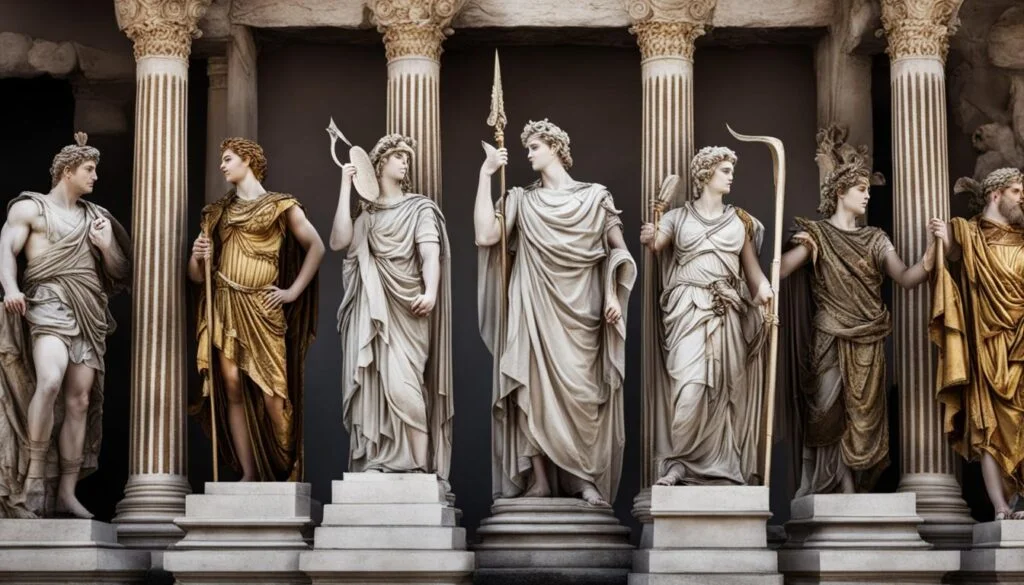In the realm of Roman mythology, Vesta reigns as the goddess of the hearth, home, and family. Known also as Hestia in Greek mythology, she holds a position of great importance among the Roman deities. Vesta embodies the protection, warmth, and nourishment that emanate from the hearth, making her worship central to Roman religious life. As the guardian of the Roman people, her presence is revered and celebrated.
Key Takeaways:
- Vesta is the Roman goddess of the hearth, home, and family.
- She is also known as Hestia in Greek mythology.
- Vesta’s worship is essential in Roman religious life.
- She is revered as the guardian of the Roman people.
- The Vestalia festival is among the most significant Roman holidays dedicated to Vesta.
Vesta’s Role in Roman Religion
Vesta played a crucial role in Roman religion as the goddess of the hearth and home. She held a prominent position in the Roman pantheon, being considered one of the Dii Consentes, the twelve most honored gods. As a central figure in Roman mythology, Vesta’s worship and rituals were integral to the religious and social fabric of ancient Rome.
The Temple of Vesta, located in Rome, served as a significant cult center dedicated to the goddess. In this temple, the sacred fire, representing Vesta’s presence, burned continuously. The responsibility of tending the sacred fire fell upon the Vestal Virgins, priestesses chosen to serve Vesta. These Vestal Virgins, known for their unwavering chastity, guarded the sacred objects within the temple, prepared flour and sacred salt for sacrifices, and maintained the sacred fire at the temple hearth.
The Vestal Virgins played a crucial role in Roman society as their chastity was believed to ensure the survival and prosperity of Rome. Any violation of their vow of virginity was met with severe punishment, reflecting the importance placed on their role in upholding religious and societal values.
In Vesta’s temple, various sacred objects held great significance in Roman religion. These objects included artifacts used in religious ceremonies, as well as gifts offered by devotees seeking Vesta’s blessings. The meticulous care and reverence accorded to these objects reflected the deep respect and devotion towards Vesta.
Vesta’s role as the guardian of the hearth and home made her an essential deity in the Roman pantheon. The worship of Vesta and the dedication of the Vestal Virgins exemplified the importance of maintaining domestic harmony, protection, and nourishment. The enduring legacy of Vesta can be seen in the symbolism of the hearth and the concept of home, which continue to hold significant meaning in modern societies.
Vesta’s Family and Greek Equivalent
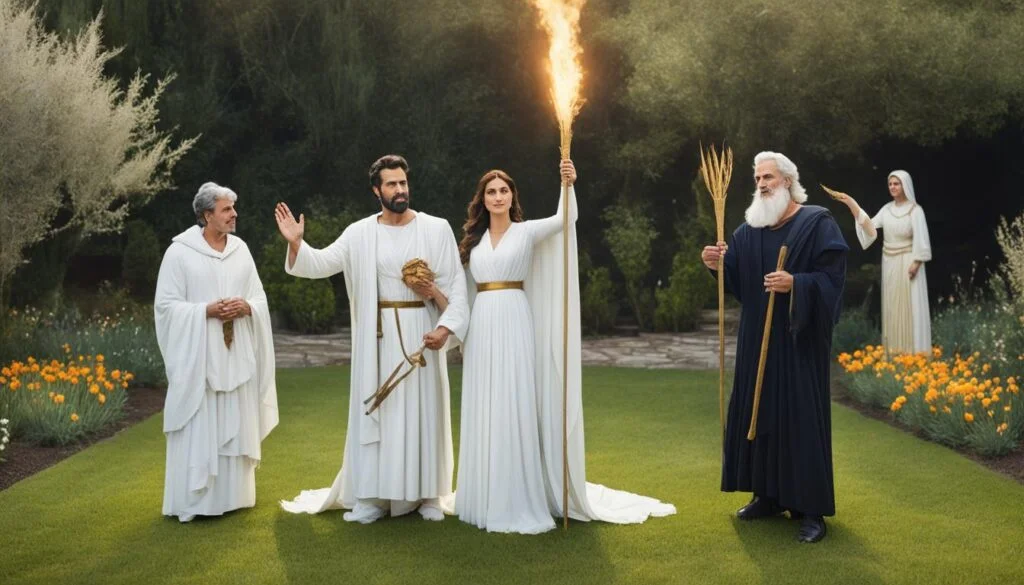
Vesta, the Roman goddess of the hearth, came from a divine lineage. She was the daughter of Saturn and Ops, making her the sister of Jupiter, Neptune, Pluto, Juno, and Ceres. Vesta’s parents, Saturn and Ops, were prominent gods in Roman mythology, and her siblings were powerful deities as well. Together, they formed the influential pantheon of gods worshipped by the ancient Romans.
In Greek mythology, Vesta has a parallel counterpart named Hestia. Hestia shares similar characteristics and roles with Vesta as she also presided over the hearth and home. Both goddesses embody the spirit of domesticity, warmth, and family. While Hestia holds a more prominent place in Greek mythology, Vesta’s position in Roman mythology highlights the strong influence of Greek culture on Roman religious beliefs.
The image above depicts Vesta’s family tree and the connection between her Roman lineage and her Greek equivalent, Hestia.
Vesta’s Symbolism and Depictions
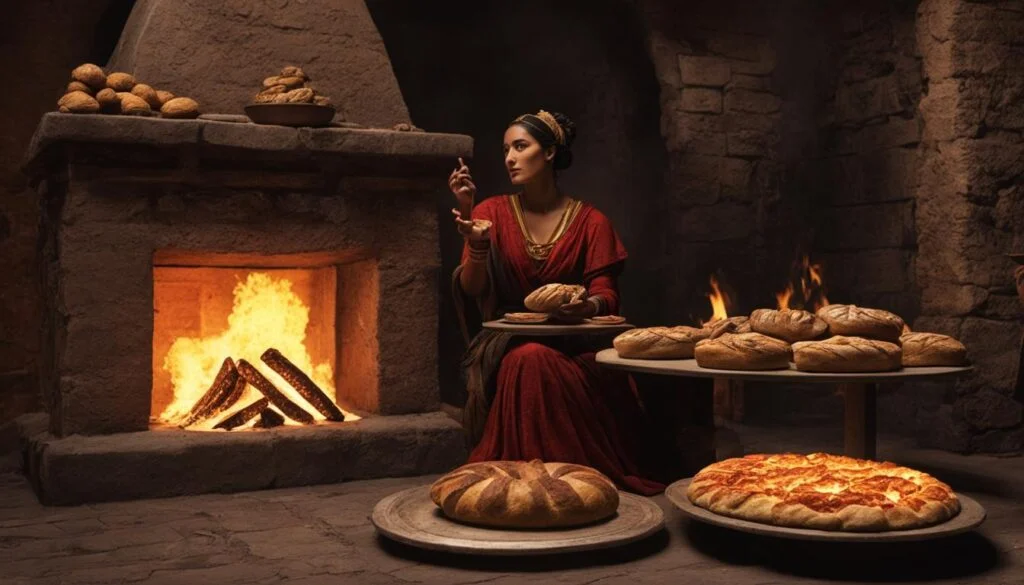
Vesta, the Roman goddess of the hearth and home, is rich in symbolism and depictions that encompass her significance in Roman mythology. One of the most prominent symbols associated with Vesta is the hearth itself. As the guardian of the hearth, Vesta represents warmth, protection, and nourishment for the Roman households.
Depicted as a veiled goddess, Vesta’s veiled form emphasizes her virginity and purity. It serves as a symbol of her devotion to her role as the guardian of the hearth. Her chastity was highly regarded, and any breach of it was severely punished.
In addition to the hearth symbol, Vesta’s depictions often incorporate symbolic fire. The sacred fire that burned continuously in her temple symbolized Vesta’s eternal presence and the perpetual flame of the hearth, providing light, warmth, and nourishment to the Roman households.
One notable depiction of Vesta can be found in a bakery in Pompeii. In this representation, Vesta is portrayed as a central figure in human form, showcasing her importance and reverence in Roman society.
Overall, Vesta’s symbolism and depictions convey her role as the protector and nurturer of the Roman hearth and home, representing the essential elements necessary for a thriving household.
Vesta’s Origins and Mythological Birth
According to Roman tradition, Vesta’s worship traces its origins back to Lavinium, the first settlement of Trojan refugees led by Aeneas. The cult of Vesta was later established in Alba Longa during the reign of either Romulus or Numa Pompilius. Vesta’s mythological birth is intertwined with the birth of her siblings, Jupiter, Neptune, Pluto, Juno, and Ceres. As the daughter of Saturn and Ops, Vesta was swallowed by Saturn, just like her siblings, but was saved and born last after Saturn’s overthrow by Jupiter.
Vesta’s connection to the founding of Rome can be seen in the myths surrounding Romulus and Remus. It is said that Vesta miraculously impregnated a virgin priestess through a phallus that appeared in the flames of the sacred hearth, resulting in the birth of the twin brothers. Additionally, Roman traditions mention Vesta’s role in the conception of Servius Tullius, a benevolent and influential king of Rome.
Despite her enigmatic origins and mystical birth, Vesta’s enduring presence in Roman mythology and religion highlights her importance as the guardian of the hearth and the sacred fire. Let’s explore Vesta’s symbology and depictions in the next section.
Vesta’s Names and Etymology
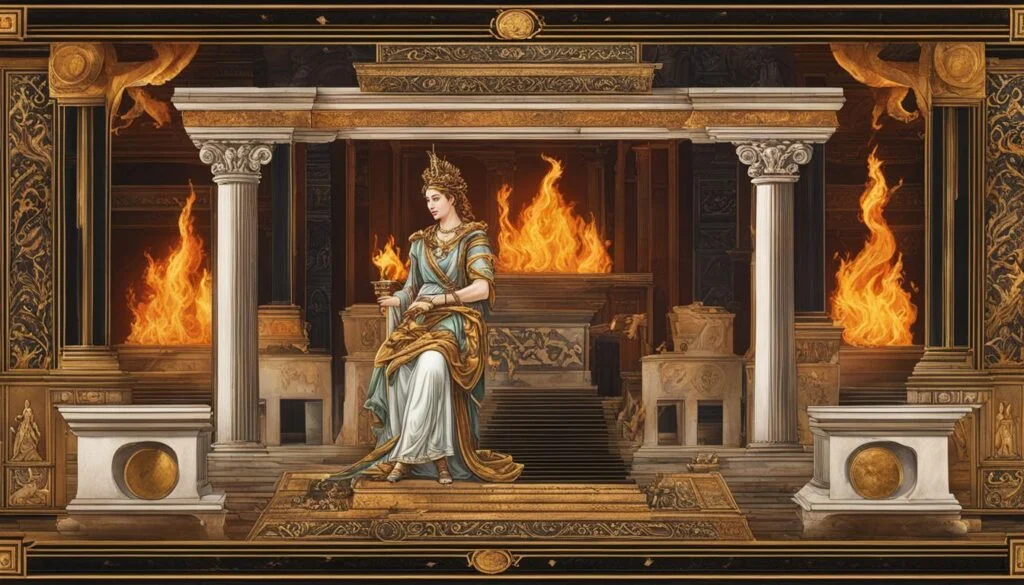
The name Vesta is derived from the Latin word “vestio,” meaning “to clothe,” and is related to the Greek word “hestia,” which means “hearth” or “fireplace.” Vesta is also associated with the Latin word “vi stando,” which translates to “standing by power.”
Her Greek equivalent, Hestia, has different etymological origins but shares similar meanings. The names of Vesta and Hestia reflect their association with the hearth and their role in providing warmth and stability to the home.
Vesta’s Worship and Festivals
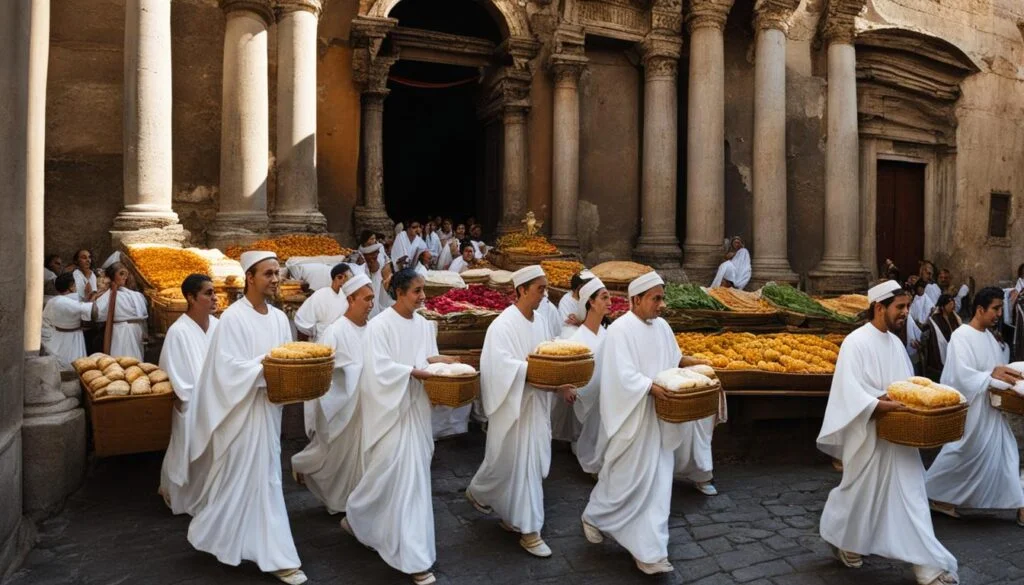
Vesta’s worship held great importance in Roman religious life, particularly within private homes. The Temple of Vesta stood as a central place of devotion, with the Vestal Virgins tending to the eternal flame within. Among the significant festivals dedicated to Vesta was the Vestalia, a week-long celebration from June 7th to June 15th. During the Vestalia, barefoot maidens participated in a grand procession to the Temple of Vesta, presenting offerings to the goddess and seeking her blessings. The festival also featured specific days dedicated to honoring the crucial contributions of asses and donkeys in Roman agriculture.
Vestalia: A Celebration of Vesta
- Duration: June 7th to June 15th
- Procession to the Temple of Vesta
- Presentation of offerings to the goddess
- Honoring of asses and donkeys
In the image above, the Vestalia procession to the Temple of Vesta symbolizes the reverence and devotion shown towards the goddess during this important festival.
Vesta’s Symbolic Objects

Vesta, as the guardian of the hearth and home, is associated with several symbolic objects that embody her role and significance in Roman mythology.
-
Hearth Symbol: The hearth is a central symbol of Vesta’s domain. It represents warmth, protection, and nourishment, serving as the heart of the home and the source of life-sustaining fire.
-
Sacred Fire: The sacred fire, constantly burning in Vesta’s temple, is a powerful emblem of her divine presence and protection. It symbolizes the eternal flame that brings light, warmth, and stability to the community.
-
Wooden Phallus: In some depictions, Vesta is shown holding a wooden phallus, symbolizing her status as a virgin goddess and her unwavering purity. This object signifies her unbreakable chastity and dedication to her divine duties.
-
Pork Symbol: Another symbol commonly associated with Vesta is the offering of pork. This represents the sacrificial meat presented to Vesta and highlights her connection to the sacred flame in Olympia, emphasizing her role as a goddess of both the hearth and communal rituals.
The symbolic objects associated with Vesta reflect her importance in Roman society and mythology, as well as her role as the guardian of the hearth and the divine protector of the home.
Vesta’s Appearance and Attributes
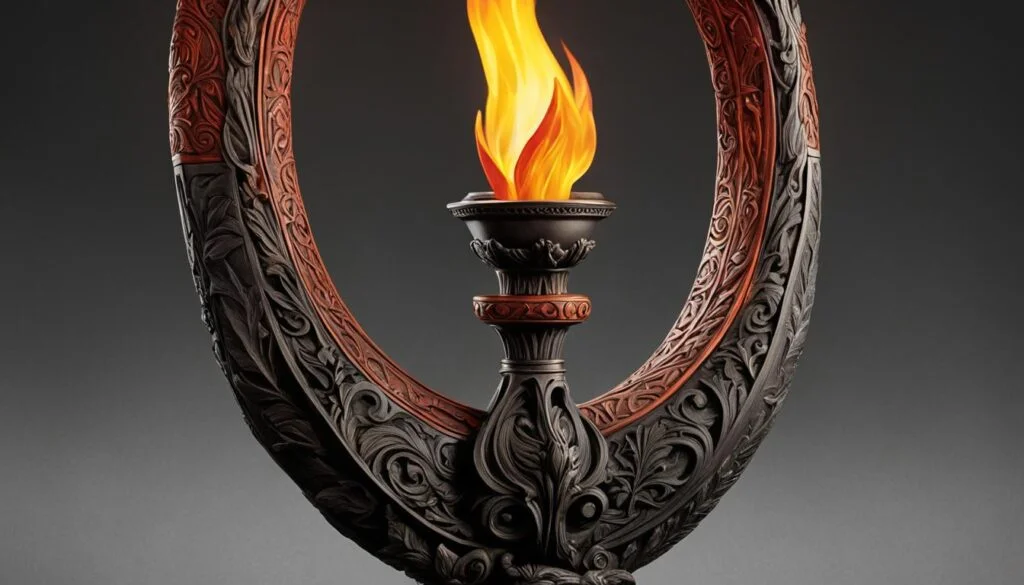
Vesta’s portrayal in art often depicts her as a middle-aged woman with a stern expression, embodying a sense of wisdom and authority. She stands as a matronly figure, radiating strength and dignity. Clothed in flowing garments, she signifies her virginity and chastity, which are central to her identity as a goddess.
One of the most recognizable attributes of Vesta is the torch she holds with both hands. This torch symbolizes her role as the guardian of the hearth and the provider of warmth and light. It represents the sacred flame that burns eternally in her temple, a symbol of the perpetual fire that ensures the well-being and nourishment of the Roman people.
Vesta’s association with the sacred flame imbues her with a sense of divine power and protection. As the keeper of the hearth, she safeguards the home and family, offering comfort and stability. The sacred flame is a powerful symbol of her enduring presence and the eternal essence of the hearth. It represents the continuity of life and the bond that holds families together.
In Roman mythology, Vesta’s appearance and attributes personify her role as the guardian of the hearth and the embodiment of the sacred flame. Her image, with her torch and matronly figure, serves as a reminder of the warmth, protection, and nourishment that the hearth provides to every Roman home.
Vesta’s Significance and Enduring Legacy
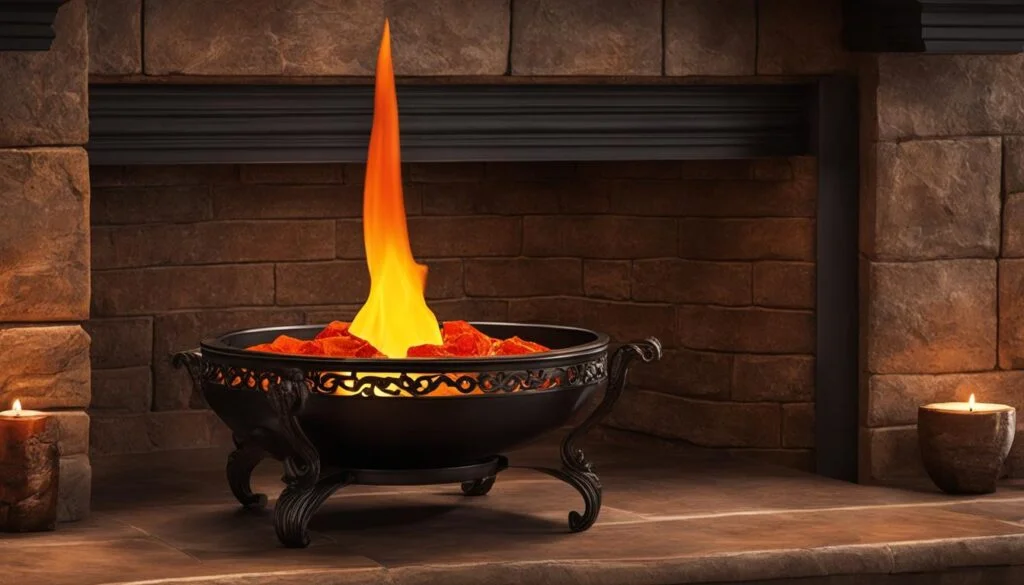
Vesta played a crucial role in Roman religion as the goddess of the hearth and home. Her significance cannot be overstated, as she ensured the well-being and protection of Roman households. As the guardian of the hearth, Vesta symbolized warmth, nourishment, and domestic stability.
The worship of Vesta and the maintenance of the sacred fire at her temple were integral to the religious and social fabric of ancient Rome. The Vestalia festival, held in her honor, was one of the most important Roman holidays. This enduring devotion to Vesta as one of the last non-Christian cults in Rome reflects her enduring legacy.
However, with the decline of paganism and the rise of Christianity, Vesta’s worship was forcibly disbanded by the Christian emperor Theodosius I in AD 391. Despite this, Vesta’s legacy lives on through the enduring symbolism of the hearth and the concept of home. The importance of Vesta to Roman religion underscores her lasting impact on Roman culture and spirituality.
Vesta’s Significance and Enduring Legacy:
- Guardian of the hearth and home.
- Ensured the well-being and protection of Roman households.
- Integral role in Roman religious and social life.
- Devotion reflected in the Vestalia festival.
- One of the last non-Christian cults in Rome.
- Symbolism of the hearth and the concept of home endures.
Vesta in Comparison to Hestia
Vesta and Hestia are closely related deities in Roman and Greek mythology, respectively. Vesta, the Roman counterpart of Hestia, and Hestia both hold important positions as the presiding goddesses of the hearth and the home. They symbolize domestic order and familial faith, embodying the values and virtues associated with the hearth and its role in daily life.
Despite their similarities, there are notable differences between Vesta and Hestia. In Greek mythology, Hestia enjoys a more prominent presence, often appearing in various stories and episodes. On the other hand, Vesta is depicted as a stoic and less prominent figure in Roman mythology.
Both goddesses share a devotion to the welfare and well-being of the home and family. They emphasize the importance of maintaining the sacred fire and provide warmth, protection, and nourishment to the household. Their roles and attributes demonstrate the significance of the hearth as a central aspect of domestic life in ancient times.
- Similarities between Vesta and Hestia:
- Preside over the hearth and the home
- Symbolize domestic order and familial faith
- Devotion to the welfare and well-being of the home and family
- Differences between Vesta and Hestia:
- Hestia is more prominently featured in Greek mythology
- Vesta is often depicted as a more stoic and less prominent figure in Roman mythology
Overall, Vesta and Hestia play essential roles in their respective mythologies, embodying the virtues and responsibilities associated with the hearth and home. Despite their differences, both goddesses are honored and revered for their commitments to the well-being and harmony of the household and family life.
Conclusion
Vesta, the Roman goddess of the hearth, home, and family, holds a significant role in Roman mythology and religion. As the Guardian of the Hearth, she embodies the warmth, protection, and nourishment that are essential for the well-being and prosperity of Roman households. The enduring legacy of Vesta can be observed through the symbolism of the hearth and the concept of home, which continue to hold cultural and emotional significance.
Vesta’s worship and the devotion of the Vestal Virgins exemplify the importance of her role in Roman society. The Vestal Virgins, priestesses dedicated to Vesta’s service, safeguarded the sacred fire in her temple and carried out various sacred duties. Their commitment to purity and the perpetuity of the sacred flame demonstrates the reverence and significance bestowed upon Vesta.
While Vesta may not have the same level of prominence in mythology as other Roman deities, her influence and significance cannot be understated. Her enduring legacy lives on, reminding us of the importance of the hearth, family, and the sense of home that she represents. Vesta continues to inspire and resonate with people, allowing her to remain an enduring figure in Roman mythology and a symbol of the enduring power of the hearth.
FAQ
Who is Vesta?
Vesta, also known as Hestia in Greek mythology, is the Roman goddess of the hearth, home, and family.
What is Vesta’s role in Roman religion?
Vesta played a vital role in Roman religion as the goddess of the hearth and home. She was considered a member of the Dii Consentes, the twelve most honored gods in the Roman pantheon. The Temple of Vesta in Rome served as a major cult center, housing the sacred fire that was tended by the Vestal Virgins, priestesses dedicated to Vesta’s service.
What is Vesta’s family and Greek equivalent?
Vesta was the daughter of Saturn and Ops, making her the sister of Jupiter, Neptune, Pluto, Juno, and Ceres. In Greek mythology, Vesta’s equivalent is Hestia, who also presided over the hearth and home.
What are Vesta’s symbolism and depictions?
Vesta’s symbolism is closely associated with the hearth and fire. She was often depicted as a veiled goddess, emphasizing her virginity and purity. The hearth itself was a symbol of Vesta and represented warmth, protection, and nourishment. Vesta’s presence was also symbolized by the fire of her temple, which burned continuously.
What are Vesta’s origins and mythological birth?
According to Roman tradition, Vesta’s worship originated in Lavinium, the first settlement of Trojan refugees led by Aeneas. Vesta’s mythological birth is intertwined with the birth of her siblings. As the daughter of Saturn and Ops, she was swallowed by Saturn like her siblings but was later saved and born last after the overthrow of Saturn by Jupiter.
What are Vesta’s names and etymology?
The name Vesta is derived from the Latin word “vestio,” meaning “to clothe,” and is related to the Greek word “hestia,” which means “hearth” or “fireplace.”
What is Vesta’s worship and festival?
Vesta’s worship was central to Roman religious life, particularly in the context of private homes. The Temple of Vesta served as a central place of worship, where the eternal flame was maintained by the Vestal Virgins. One of the most important festivals dedicated to Vesta was the Vestalia, which lasted for a week from June 7th to June 15th.
What are Vesta’s symbolic objects?
Vesta is associated with several symbolic objects that represent her role as the guardian of the hearth and home. The hearth itself is a central symbol, representing warmth, protection, and nourishment. The sacred fire, which burned continuously in her temple, is another important symbol of Vesta.
What is Vesta’s appearance and attributes?
Vesta’s appearance is often depicted as that of a middle-aged woman with a stern expression. She is typically shown holding a torch with both hands, symbolizing her role as the guardian of the hearth and the provider of warmth.
What is Vesta’s significance and enduring legacy?
Vesta’s significance in Roman religion cannot be overstated. As the goddess of the hearth and home, she played a vital role in ensuring the well-being and protection of Roman households. Vesta’s enduring legacy can be seen in the symbolism of the hearth and the concept of home.
How does Vesta compare to Hestia?
Vesta and Hestia are closely related deities, with Vesta being the Roman counterpart of the Greek goddess Hestia. Both goddesses preside over the hearth and the home, symbolizing domestic order and familial faith.
What is the conclusion about Vesta?
Vesta, the Roman goddess of the hearth, home, and family, plays a central role in Roman mythology and religion. As the guardian of the hearth, she symbolizes warmth, protection, and nourishment, ensuring the well-being and prosperity of Roman households. Vesta’s enduring legacy can be seen in the symbolism of the hearth and the concept of home.



